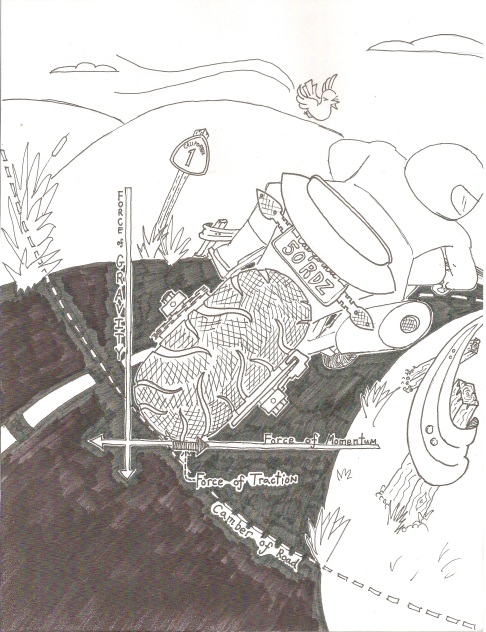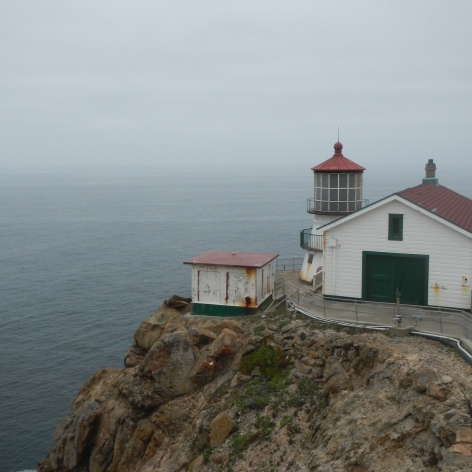The Lighthouse and the Lightbulb
by fiftyrides
 I’m sitting at home with my legs up and ice on my knees. South Park is on the TV and there’s a Lagunitas Daytime Ale on the couch next to me, supported by my copy of David Macaulay’s “The Way Things Work.” Life is pretty good.
I’m sitting at home with my legs up and ice on my knees. South Park is on the TV and there’s a Lagunitas Daytime Ale on the couch next to me, supported by my copy of David Macaulay’s “The Way Things Work.” Life is pretty good.
We just got back from the Point Reyes Lighthouse and, though it’s trite to say, it was an epic ride. 136 miles of twisting coastal roads that resulted in a real lightbulb moment for my sportbike riding.
The lighthouse is a unique piece of history perched out on the edge of the Pacific. Crafted in 1870, the ornate, rotating fresnel lens (pronounced “frennal”) is a glimmering view into a world gone by. The cliffside buildings also house of a collection of maritime warning devices. The light remained the same until recently, but the fog horns have changed over the decades. The first whistle was steam-powered, demanding 140 lbs of coal be shovel into a boiler every hour — eight tons a year.
The Coast Guard attendants spent endless hours scrubbing soot off of the intricate clockwork mechanisms. When not doing that, they were sanding away rust and painting the cast iron buildings. The park ranger giving the history lesson today didn’t mention how much alcohol the attendants consumed, but I’d guess it was the second most important commodity after coal.
On the way back from the lighthouse, my friend hooked up his gopro and had me ride in front. It provided the motivation to ride aggressively. I imagined him saying, “Get ill, dude!” or “Get after it!” So I was pushing things, trying intently to hold my lines, leaning hard around blind turns.
Keep in mind that the lighthouse road is pretty crap. Really: it’s beautiful and bumpy as hell. Pot holes that could swallow a Volkswagon speckle a ribbon of asphalt that winds between rolling hills, passing estuaries, marshes and vast green fields. It sweeps down into cattle farms and climbs suddenly around craggy protrusions of sand stone.
The road conditions forced me to get my butt up off the seat, just like downhill mountain biking. Suddenly I was whipping the bike around with much more authority, in control like never before. I had been riding in the saddle waaaaay too much. Now that I was floating over the bumps, using my legs as shock absorbers, I could really feel the bike on a different level.
Once we got onto the more forgiving pavement of Highway One, things kept clicking. I found I had been bunching against the tank too much and eased myself back, putting a longer bend into my knees. I’ve done plenty of out-of-the-saddle riding before, but the Yamaha R6 required the most aggressive posture and technique I’ve experienced yet. Basically, you get on all fours, slam the bike towards the ground while entering the turn, then use the throttle to catch yourself, using momentum to pull the bike back towards standing. Between pressure on the pegs, handlebar and throttle there’s a balance that lets the bike rip through turns like a sawblade rollercoaster.
The amount of actual lean that the bike has is kind of ridiculous. After feeling the turns in this new way, lowsiding stopped being a concern. All that was really important was whether I was drifting to the road’s edge and whether the bike was scraping the ground (didn’t experience any of the latter). I was pushing my angle of lean farther than ever before and it felt great.
All bikes, no matter how large or small have an range of lean at which they pretty much stay upright. After a certain point — the tipping point — gravity starts winning the fight. At complete rest, when the bike isn’t moving at all, a little motion either way makes the difference in keeping the rubber side down. (Try keeping both feet on the pegs at complete stop. If you can go longer than three seconds, you might want to considering quitting your day job and start riding full time.) But as speed increases, gravity takes second place to the bike’s forward momentum. It’s too preoccupied with moving ahead to fall towards the ground. As we go faster, the possible angle of lean becomes less dependent on gravity and is dictated much more by traction.
Anyway, an aggressive turn is a delicate dance between traction, gravity and forward momentum. Really good racers are actually dealing with slipping traction, which just blows my mind, considering the forces I just felt. Accelerating hard out of a turn, experiencing G-pull while leaned so far that I was looking side-ways at the road was a hellova rush — more like a rope swing than a bike.
It’s one thing to understand the physics of an aggressive turn, how opposing forces carve a vector into an invisible, three-dimensional graph. It’s another thing to climb inside that equation and get shot out of an uphill right-hand turn on a seaside road, screaming inside your helmet.


